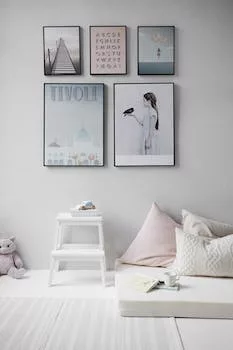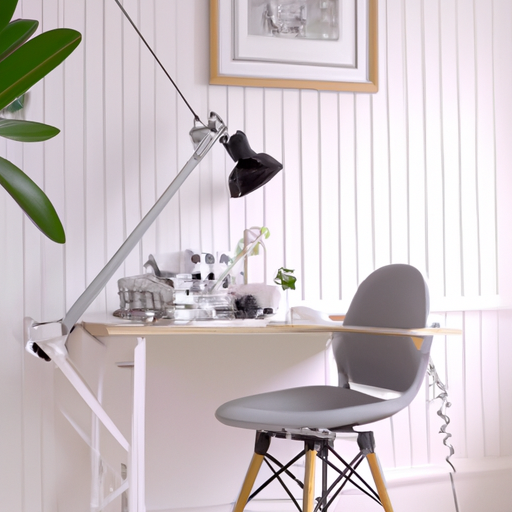Creating a Safe and Functional Nursery Layout
Designing a home that is perfect for a nursery requires careful planning and consideration of various factors. A nursery should not only be a beautiful and comfortable space for your baby, but it should also be safe and functional. In this article, we will discuss some essential tips for creating a nursery layout that is both safe and functional.
First and foremost, it is crucial to choose the right location for the nursery. Ideally, the nursery should be situated in a quiet part of the house, away from noise and distractions. This will help ensure that your baby can sleep peacefully without being disturbed by household activities. Additionally, the nursery should be easily accessible from the master bedroom, allowing parents to quickly attend to their baby’s needs during the night.
Once you have selected the ideal location for the nursery, it is time to consider the room’s layout. The layout should be designed to maximize safety and functionality while still maintaining a visually appealing aesthetic. One of the most important aspects of a nursery layout is the placement of the crib. The crib should be positioned away from windows, heaters, and electrical outlets to minimize potential hazards. It is also essential to ensure that there are no cords or strings within reach of the crib, as these can pose a strangulation risk.
Another critical aspect of a nursery layout is the inclusion of ample storage space. Babies require a surprising amount of gear, from clothing and diapers to toys and books. Incorporating sufficient storage solutions into the nursery design will help keep the room organized and clutter-free. Consider using a combination of open shelving, closed cabinets, and storage bins to accommodate all of your baby’s belongings.
In addition to storage, it is essential to create designated areas for specific activities within the nursery. For example, a comfortable and well-lit area should be set aside for feeding and rocking your baby. This area should include a comfortable chair or glider, a side table for holding bottles and burp cloths, and a soft, dimmable light source for late-night feedings. Similarly, a designated changing area should be established, complete with a sturdy changing table, a diaper pail, and easy access to diapers and wipes.
When designing a nursery layout, it is also important to consider the room’s lighting. The nursery should have a combination of ambient, task, and accent lighting to create a warm and inviting atmosphere. Ambient lighting can be achieved through the use of ceiling fixtures or floor lamps, while task lighting can be provided by table lamps or wall sconces placed near the changing table and feeding area. Accent lighting, such as string lights or a decorative nightlight, can add a touch of whimsy and charm to the nursery.
Finally, safety should be a top priority when designing a nursery layout. All furniture should be sturdy and secure, with no sharp edges or corners that could pose a risk to your baby. Additionally, all electrical outlets should be covered with safety plugs, and window treatments should be free of cords or strings that could pose a strangulation hazard.
In conclusion, designing a home that is perfect for a nursery involves careful consideration of the room’s location, layout, storage, lighting, and safety features. By taking the time to plan and design a nursery that is both safe and functional, you can create a beautiful and nurturing environment for your baby to grow and thrive.
Selecting the Ideal Color Palette for Your Baby’s Room

Designing a home that is perfect for a nursery requires careful consideration of various factors, including the color palette. The color scheme of your baby’s room can have a significant impact on their mood, development, and overall well-being. Therefore, it is essential to choose the right colors that will create a nurturing and soothing environment for your little one. In this article, we will discuss the importance of selecting the ideal color palette for your baby’s room and provide some tips on how to achieve this.
The first step in selecting the ideal color palette for your baby’s room is understanding the psychological effects of colors. Research has shown that colors can influence our emotions, behavior, and even our physiological reactions. For instance, warm colors such as red, orange, and yellow are known to evoke feelings of warmth, comfort, and excitement, while cool colors like blue, green, and purple can create a sense of calm, relaxation, and serenity. Therefore, it is crucial to choose colors that will promote a positive atmosphere in your baby’s room.
One popular approach to selecting the ideal color palette for your baby’s room is to use gender-neutral colors. This can be particularly helpful if you do not know the gender of your baby or if you plan to have more children in the future. Gender-neutral colors such as beige, gray, and white can create a calming and soothing environment that is suitable for both boys and girls. Additionally, these colors can be easily complemented with other colors and patterns, allowing you to personalize the room according to your preferences.
Another important factor to consider when selecting the ideal color palette for your baby’s room is the amount of natural light the room receives. Rooms with ample natural light can benefit from cooler colors, as they can help balance the warmth of the sunlight. On the other hand, rooms with limited natural light may benefit from warmer colors to create a cozy and inviting atmosphere. It is also essential to consider the size of the room, as lighter colors can make a small room appear more spacious, while darker colors can make a large room feel more intimate and cozy.
When selecting the ideal color palette for your baby’s room, it is also essential to consider the room’s primary function. For instance, if the room will primarily be used for sleeping and relaxation, it is advisable to choose colors that promote a sense of calm and tranquility, such as soft blues, greens, and purples. However, if the room will also serve as a play area, you may want to incorporate more vibrant and stimulating colors, such as bright yellows, oranges, and reds.
Finally, it is important to remember that your baby’s room should be a reflection of your personal style and preferences. While it is essential to consider the psychological effects of colors and the room’s function, it is also crucial to choose colors that you find aesthetically pleasing and that complement the overall design of your home. By doing so, you will create a space that is not only nurturing and soothing for your baby but also a room that you enjoy spending time in.
In conclusion, selecting the ideal color palette for your baby’s room is a crucial aspect of designing a home that is perfect for a nursery. By considering the psychological effects of colors, the room’s function, and your personal style, you can create a nurturing and soothing environment that promotes your baby’s well-being and development. With careful planning and attention to detail, you can design a home that is perfect for a nursery and create a space that both you and your baby will love.
Incorporating Multi-Purpose Furniture for a Growing Child
Designing a home that is perfect for a nursery requires careful planning and consideration of various factors. One of the most important aspects to consider is incorporating multi-purpose furniture that can adapt to the needs of a growing child. This not only saves space but also ensures that the nursery remains functional and stylish as your child grows. In this article, we will discuss some tips and ideas on how to design a home that is perfect for a nursery by incorporating multi-purpose furniture.
When designing a nursery, it is essential to think about the long-term use of the space. As your child grows, their needs and preferences will change, and the nursery should be able to adapt to these changes. One way to achieve this is by investing in multi-purpose furniture that can serve different functions as your child grows. For example, a crib that can be converted into a toddler bed and later into a full-sized bed will save you the trouble of buying new furniture as your child grows. Similarly, a changing table that can be transformed into a dresser or a bookshelf will ensure that the nursery remains functional and stylish even when your child no longer needs a changing table.
Another important aspect to consider when incorporating multi-purpose furniture in a nursery is storage. As your child grows, so will their collection of clothes, toys, and other belongings. Therefore, it is essential to invest in furniture that offers ample storage space. For instance, a crib with built-in drawers or a changing table with shelves can help keep the nursery organized and clutter-free. Additionally, consider investing in furniture that can be easily reconfigured or repurposed, such as modular shelving units or storage cubes that can be rearranged to create different storage solutions as your child’s needs change.
When selecting multi-purpose furniture for a nursery, it is crucial to prioritize safety and durability. Ensure that the furniture you choose meets safety standards and is made from high-quality materials that can withstand the wear and tear of daily use. Additionally, opt for furniture with rounded edges and corners to minimize the risk of injuries as your child starts to explore their surroundings.
Incorporating multi-purpose furniture in a nursery also allows for more flexibility in terms of design and layout. As your child grows and their interests change, you can easily rearrange the furniture to create a space that reflects their personality and preferences. For example, a modular shelving unit can be reconfigured to display your child’s favorite books and toys, while a convertible crib can be transformed into a cozy reading nook or a play area.
Lastly, when designing a nursery with multi-purpose furniture, it is essential to consider the color scheme and overall aesthetic of the space. Opt for neutral colors and timeless designs that can easily adapt to your child’s changing tastes and preferences. This will ensure that the nursery remains stylish and cohesive even as the furniture is repurposed or rearranged to accommodate your child’s growing needs.
In conclusion, incorporating multi-purpose furniture in a nursery is an excellent way to create a functional and stylish space that can adapt to the needs of a growing child. By investing in furniture that can serve multiple functions, prioritizing safety and durability, and opting for a flexible design and layout, you can design a home that is perfect for a nursery. With careful planning and consideration, your child’s nursery can be a space that grows with them, providing comfort and functionality throughout their childhood.
Q&A
Question 1: What are the essential elements to consider when designing a home with a nursery?
Answer: The essential elements to consider when designing a home with a nursery include a safe and comfortable space, adequate room for furniture and storage, and proper lighting and ventilation.
Question 2: How can one create a functional and versatile layout for a nursery?
Answer: To create a functional and versatile layout for a nursery, consider placing the crib in a central location, providing ample storage solutions such as shelves and cabinets, and creating designated areas for changing, feeding, and playtime.
Question 3: What are some tips for choosing the right color scheme and decor for a nursery?
Answer: When choosing the right color scheme and decor for a nursery, consider using calming and soothing colors, incorporating gender-neutral tones, and selecting age-appropriate and easily adaptable decorations and furnishings.
Conclusion
In conclusion, designing a perfect nursery requires careful planning and consideration of factors such as safety, functionality, comfort, and adaptability. By incorporating elements like appropriate furniture, storage solutions, soothing colors, and engaging decor, you can create a nurturing and stimulating environment that supports your child’s growth and development.


